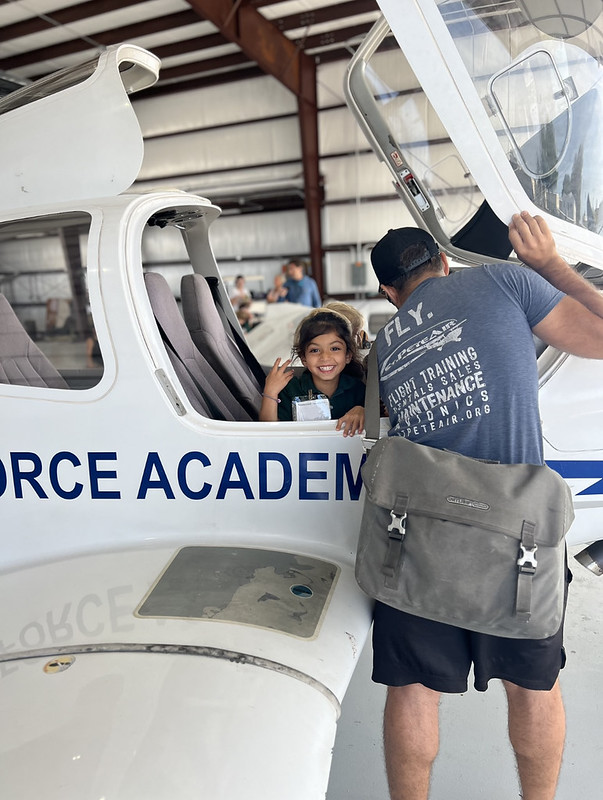

JK Airplane Learning Journey
Inspired by an in-depth exploration of birds in their first semester of school, Dr. Q’s Junior Kindergarten class expressed a fascination with airplanes throughout the second semester. From understanding the experience of being aboard an airplane to unraveling the mysteries of flight mechanics, the preschoolers have been on a thrilling journey!
The children crafted cardboard airplane models and a control tower. They collaborated over several days to create a large, interactive airport map, including a terminal with a baggage check, a control tower, runways, a taxiway, a repair area, and more. The children enjoy interacting with the map with toy planes and vehicles, continuously adding more features.
“We need tickets,” Navya said. “They can have numbers on them. Normally on the plane, the flight attendants help people find the right seat to sit in, and the seats have to have numbers on them to match the tickets.”
Charlotte said, “Frankie and I are going to turn our classroom into an airplane with rows of seats and a screen to watch and food.”
Inspired by real-life experiences, they lined up classroom chairs as airplane seats, complete with an aisle and seatbelts. Dr. Q. and Mrs. Beggins served as flight attendants, passing out snacks from a roller cart. It was a wonderful chance for the children to practice social skills, such as how to get a flight attendant’s attention without yelling or leaning over another passenger. The little ones regularly enacted flights in the classroom, rotating through the roles of pilots, flight attendants, and passengers.

Soon they shared their airplane simulation with the other JK classes during Exploring. It was a hit! All four flights were packed, and the class enjoyed sharing their learning and understandings with others.
Following the children’s specific curiosities, they learned about the Wright brothers and how they modeled early airplanes after birds. Their work in prior months involving birds informed this new realm of exploration.
They learned basic aerodynamics and how wind flow works by folding and flying paper airplanes. Teachers reinforced the concept of ‘lift’ by letting the children experiment with a wind tunnel and fabric.
Toy pilot dashboards with interactive lights, buttons, and sound effects allowed the students to take turns learning to fly. They explored the functions of different parts of the airplane, from wings to cockpit controls. They talked extensively about airplanes’ many parts, including the nose, fuselage, cabin, wings, tail, rudder, cockpit, propellers, pilot controls in the cockpit, and more.
 Special visitors enriched their understanding of aviation. Ian Britton, an Orlando-based pilot with Spirit Airlines, visited to share about his work. He walked the students through a typical day as a pilot, showed them how some of the 300+ buttons and instruments in a cockpit function, and answered wonderful questions. He brought a map of airports across the United States as well as Spirit pens. Many thanks to Matteo’s mother, Olivia, for connecting the class with Ian!
Special visitors enriched their understanding of aviation. Ian Britton, an Orlando-based pilot with Spirit Airlines, visited to share about his work. He walked the students through a typical day as a pilot, showed them how some of the 300+ buttons and instruments in a cockpit function, and answered wonderful questions. He brought a map of airports across the United States as well as Spirit pens. Many thanks to Matteo’s mother, Olivia, for connecting the class with Ian!
Next, they had a special visit from Mrs. Summers’ husband, Brendan, who served in the Army flying a Chinook and now serves as a helicopter pilot and skydiving instructor. He shared about ways in which helicopters and airplanes are the same and ways in which they are different, and he brought a parachuting backpack, a helmet, and sample helicopter controls.
Students asked questions such as:
"Do you fly around the whole world in one airplane?"
"How many people can about fit on your plane?"
"Did you fly the Jets or the Yankees?"
St. Pete Aviation Services flight school is at nearby Albert Whitted Airport. In March the class visited and toured a private hangar and took turns climbing into an actual airplane in pairs. They also observed airplanes take off and land in the distance. Thank you to the wonderful parent chaperones for assisting!
When the students returned to school, they spoke, drew, and wrote about their experiences, and brainstormed additional ways to apply what they saw to their classroom explorations. The children also considered what they might see outside of our airplane windows and began drawing what they imagined.
Their curiosity sparked rich discussions. After one child asked if airplanes can go all the way to outer space, Conor said, “No, they’d run out of gas,” and William added, “No, because they would float around.” They then consulted literary and online resources for answers, learning about space planes and how they are different from regular airplanes.
In April they made airplane-themed snacks using cheese, crackers, grapes, and carrots. Attaching the items together with toothpicks added some fine motor skill building.
Students applied their literacy skills to create “Shorecrest Airlines” plane tickets, signs, invitations and the like for an airplane party to which they invited their families. The “Shorecrest Airlines” party that concluded their exciting journey was truly first class! The children served as gate agents, pilots, and flight attendants while the adult guests were passengers and enjoyed an in-flight magazine and a movie. The sky's the limit for these young Chargers!

























![JK on the Run [Photos] JK on the Run [Photos]](/Images/1px.png?command_1=url&url_1=https%3A%2F%2Fwww.shorecrest.org/userfiles/shpsv2mvc/images/news-images/JKontherun.jpg&command_2=resize&height_2=85)